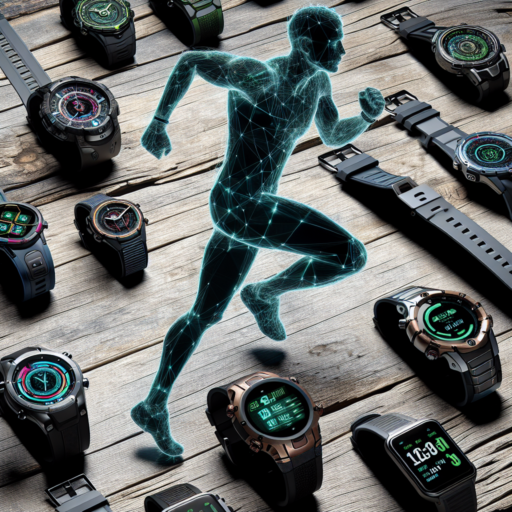Why Every Athlete Needs a Smartwatch
In the realm of sports and athletics, smartwatches have proliferated as not just a trend but a necessity. These sophisticated devices offer a plethora of features that cater specifically to the unique needs of athletes, enhancing their training, performance, and recovery processes. From tracking vitals to offering personalized training programs, the reasons for an athlete to invest in a smartwatch are compelling and manifold.
One of the pivotal benefits a smartwatch provides is its ability to monitor various health metrics, such as heart rate, oxygen levels, and sleep patterns. For athletes, having access to this data in real-time allows for a tailored approach to training, enabling adjustments to intensity levels or modalities based on precise physiological feedback. Moreover, the integration of GPS tracking aids in mapping out routes and distances, a feature particularly invaluable for runners and cyclists.
Another significant advantage is the motivational aspect. Smartwatches can serve as personal coaches, pushing athletes to achieve their daily goals and milestones. They offer encouragement and, importantly, objective feedback on progress. Additionally, the ability to connect with online communities and compete in virtual races fosters a sense of community and competition, further motivating athletes to push their limits.
Top Features Athletes Love in Smartwatches
When it comes to fitness and training, smartwatches have become indispensable for athletes around the globe. These modern devices pack a punch with features specifically designed to enhance training sessions, track progress, and maintain a healthy lifestyle. Among the plethora of capabilities, certain functionalities stand out, making them must-haves for any serious athlete.
Advanced Heart Rate Monitoring
One of the most crucial aspects of any athlete’s training is monitoring their heart rate. Smartwatches with advanced heart rate monitoring capabilities allow athletes to track their heart rate in real-time, ensuring they are training within their target heart rate zones. This data is vital for optimizing performance, improving cardiovascular health, and preventing overtraining or undertraining. It’s a feature that goes beyond basic tracking, offering insights into heart rate variability (HRV) and recovery rates, which can be pivotal for planning training and rest days.
GPS Tracking and Navigation
For athletes who take their workouts to the outdoors, GPS tracking is indispensable. This feature does not merely map out your route; it provides detailed insights into pace, distance covered, and elevation gained. Whether it’s for a long-distance runner, a cyclist, or a triathlete, these metrics can help in setting and achieving performance benchmarks. Furthermore, the navigation capabilities ensure that athletes can explore new training routes without the fear of getting lost, making each workout an adventure.
Customizable Workouts and Training Plans
Smartwatches have revolutionized the way athletes train by offering customizable workouts and training plans right on their wrist. Users can tailor their training sessions according to their specific goals, be it improving endurance, speed, or strength. These devices often come with built-in training programs for a variety of sports, offering guidance and ensuring that athletes are getting the most out of every workout. Additionally, the ability to track progress and adjust plans accordingly ensures that training remains dynamic and tailored to the athlete’s evolving needs.
Comparing the Best Smartwatches for Athletes in 2023
In the rapidly evolving world of wearable technology, smartwatches have become an indispensable tool for athletes aiming to track their performance, health, and fitness levels with precision. The year 2023 brings forth an array of smartwatches, each claiming to be the best for athletic endeavors. However, distinguishing between these devices requires a deeper understanding of their features, durability, and connectivity options to match the specific needs of athletes.
The market is currently dominated by brands that have continuously refined their products to cater to the rigorous demands of sports and fitness enthusiasts. Key considerations for comparing the best smartwatches for athletes include battery life, water resistance, GPS accuracy, and the variety of workout modes available. Additionally, the integration of health monitoring tools such as heart rate sensors, oxygen level trackers, and sleep pattern analysis has also become crucial for athletes seeking to optimize their training and recovery processes.
Moreover, the compatibility of these smartwatches with various smartphone ecosystems and their ability to seamlessly sync with third-party fitness applications play a significant role in their effectiveness for athletes. This ensures not only the capture of accurate and comprehensive workout data but also enables athletes to tailor their training schedules, set goals, and monitor progress over time with ease. The blend of these factors makes the selection of the right smartwatch a pivotal decision for athletes dedicated to enhancing their performance in 2023.
How to Choose the Perfect Smartwatch for Your Athletic Needs
Choosing the perfect smartwatch for your athletic needs involves understanding the features that matter most to your workout regimen and lifestyle. With the market flooded with options, pinpointing which device can best elevate your training sessions is key. It’s not only about tracking time but about finding a wearable that complements your fitness goals and enhances your daily activities.
Identify Your Fitness Goals
Firstly, consider what you aim to achieve in your athletic journey. Whether it’s improving your running pace, diving deeper into yoga, or enhancing your swimming technique, your goals dictate the features you should look for. For runners, a smartwatch with a robust GPS and heart rate monitoring is essential. Swimmers should prioritize water resistance and stroke detection, while those into a mix of activities might benefit from a multi-sport mode.
Key Features to Consider
When delving into the features, the focus should be on those that align with your athletic needs. Battery life is crucial for endurance athletes who spend long hours training, ensuring you’re not left powerless mid-session. Health tracking capabilities, including heart rate monitoring, sleep analysis, and VO2 max estimation, offer insights into your overall fitness and recovery needs. Additionally, compatibility with other devices and apps allows for a seamless integration into your existing tech ecosystem, enabling you to keep track of your progress effortlessly.
Maximizing Your Training: Tips for Using Your Smartwatch
Integrating a smartwatch into your training routine can revolutionize the way you track progress and stay motivated. These versatile devices offer a plethora of features designed to enhance your training efficiency. However, knowing how to effectively use your smartwatch can sometimes be overwhelming. Here, we explore essential tips to maximize your training with the aid of your smartwatch, ensuring that you make the most out of every workout session.
Setting Specific Training Goals
Begin by setting specific, measurable, achievable, relevant, and time-bound (SMART) goals in your smartwatch app. Most smartwatches come equipped with customizable goal-setting features that can help you focus on specific objectives, such as running a certain distance, burning a certain number of calories, or even achieving a particular heart rate zone during workouts. By defining your training goals, you can use your smartwatch to keep you on track and motivated, providing you with instant feedback on your progress.
Utilizing Built-in Fitness Trackers
Take full advantage of the built-in fitness trackers by selecting the one that best matches your training type. Whether it’s a brisk walk, a high-intensity interval training (HIIT) session, or a peaceful yoga hour, there’s likely a feature on your smartwatch to record your workout accurately. These trackers not only measure your calories burnt but also analyze your workout pattern over time, offering insights into your training intensity and consistency. Paying attention to these metrics can significantly enhance your training effectiveness, allowing for adjustments as needed to meet your fitness goals faster.
No se han encontrado productos.
The Role of Wearable Tech in Modern Athletic Training
The integration of wearable technology into modern athletic training regimes has revolutionized the way coaches and athletes approach their workouts and performance analysis. With the advent of sophisticated devices, athletes can now monitor an array of physiological and biomechanical metrics in real-time, leading to personalized training sessions that are based on data-driven insights. These advancements in wearable tech are not just about tracking steps or heart rate; they empower athletes with detailed feedback on their physical condition, training load, and recovery status, enabling them to make informed decisions about their training programs.
One significant contribution of wearable tech in athletic training is its ability to monitor and analyze performance metrics such as speed, distance, acceleration, and even technique. This level of detailed feedback helps athletes and coaches identify specific areas that need improvement, which can be as nuanced as adjusting stride length or running posture. Furthermore, the data collected through these devices support the customization of training plans to match the physical and physiological profile of each athlete, promoting efficiency and reducing the risk of injury.
Another crucial aspect of wearable technology in sports training is its role in injury prevention and rehabilitation. Devices equipped with motion sensors and advanced analytics can detect irregular movement patterns that may signify a heightened risk of injury. By addressing these issues early on, athletes can adjust their training to avoid potential injuries. Moreover, for those in the rehabilitation phase, wearable tech offers valuable feedback on their recovery progress, ensuring that they are not pushing their bodies beyond the healing threshold.



